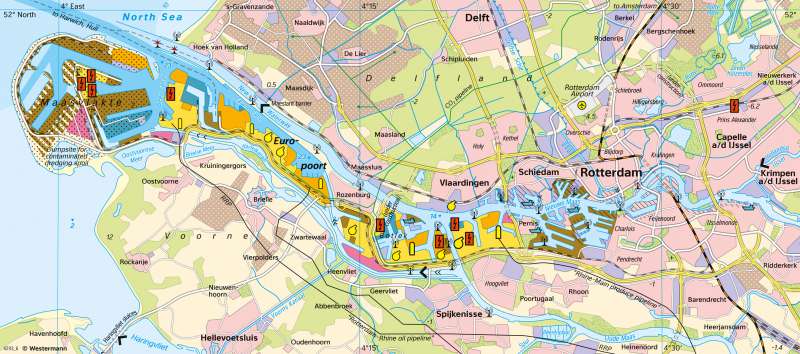Rotterdam - Sea and river port
Transport
978-3-14-100890-6 | Page 73 | Ill. 2

Overview
Rotterdam is, by handling of maritime cargo, the fourth largest seaport in the world (after Shanghai, Singapore and Tianjin) and the largest deep-sea port in Europe. Rotterdam ranks 11th in terms of container handling. The port facilities extend inside and west of the city over an area of around 40 kilometres, with the main focus on the southern shore. The port area can be divided into three large areas. In the east, the older harbours, mainly built before the Second World War, are located on the banks of the New Meuse (Nieuwe Maas), completed in 1872. To the west, on the New Waterway (Nieuwe Waterweg), are the extensions built mainly in the 1950s and 1960s, which today form the core area of Europoort, the port of Rotterdam.
Maasvlakte
The most recent part of the port area is the Maasvlakte (Maas Plain), built into the North Sea from the 1970s onwards. It is currently being expanded by around 1000 hectares of commercial area to meet the demand for space until 2030. Increasing ship sizes (up to 400 metres long, 60 metres wide and 80 metres high) have led to the creation of ever larger and deeper harbour basins in recent decades.
Expansion until 2014
The port area has grown considerably in the last 50 years alone. Towards the end of the Second World War, it covered 1400 hectares, in 7500 hectares in 1975 and in 2013 it expanded to 12 500 hectares (excluding Maasvlakte 2). Additionally, transshipment rose from 30 million tonnes in 1950 to 225 million tonnes in 1970 and finally to 450 million tonnes in 2013. Crude oil alone accounted for around 91 million tonnes of this. Rotterdam is also the most important European container port, handling a volume of around 11.6 million TEU (Twenty Feet Equivalent Unit) in 2013.
"Maasvlakte 2" is to become the new top location especially for container handling, logistics and the chemical industry. The first companies started operations there in 2013. With a fairway depth of 23.5 metres, the new port area will be accessible to the largest oil tankers and container ships currently operating. These giant ships can load up to 380,000 tonnes of crude oil or transport up to 13,000 containers - for this number of containers, a train would have to be over 80 kilometres long.
Spatial patterns
The expansion of the port and industrial areas has led to a spatial division according to the type of goods handled. The handling of containers is concentrated on the Maasvlakte and on a few areas on the southern bank. For the large container ships operating on intercontinental routes, loading takes place on the Maasvlakte. The older general cargo ports were specially converted for short-sea container traffic in Europe (mostly short-sea container traffic close to the coast).
Liquid and bulk cargo is handled mainly in the newer port areas in the west. One third of hard coal and so-called agribulk products such as grain, seeds, soybeans, maize, or tapioca reach the markets in Western Europe via Rotterdam. The same applies to about 45 percent of all ores, scrap products, minerals, and other dry bulk goods. The port is home to four oil refineries of international importance and around 40 companies in the chemical and oil industry. Rotterdam is one of the three most important oil and chemical centres in the world, along with Houston and Singapore.
Waterways and transport links
Today, there are four parallel waterways between Rotterdam and Maasvlakte. From north to south, these are the New Waterway for shipping between the North Sea and the eastern port area, the Caland Canal for maritime shipping to and from Europoort, the Hartel Canal south of Europoort for inland shipping to and from Europoort (up the Rhine to Basel without obstacles) and finally the Brielse Meer, surrounded by a green belt, which today serves recreational purposes.
Since the tidal range in the Rotterdam harbour area is no greater than about 1.60 metres, it was not necessary to separate the harbour basins from the open water with locks, as in London and Antwerp, for example. The open connection to the sea, the very deep shipping channel, the strategically favourable location in Europe and the perfect inland connections, together with the high-quality service offer, are the reasons for Rotterdam's success.
Every year, around 35,000 seagoing vessels and well over 100,000 inland vessels call at the Port of Rotterdam. The port has a large number of short sea and feeder services to more than 200 other European ports. Feeder services act as suppliers for the international sea traffic. Thus, the large ocean-going vessels of the globally-operating shipping companies only need to sail to a small number of main European ports.
Rotterdam has a well-developed network of waterways, pipelines, rail and road connections. Inland vessels reach large parts of Central, Eastern and Western Europe via the Meuse, Rhine, numerous canals and the Danube. Pipelines connect the port with the south of the Netherlands, the Ruhr area, southern Germany and Belgium. The rail network is mainly used to transport containers and bulk goods (iron ore, coal).
Because services also play an increasingly important role in the port, there are three "Distriparks" for the storage and distribution of trade goods that have arrived in containers in Rotterdam. These are sites with large warehouses and IT and communication infrastructure that are close to container terminals and at the same time well connected to the road, waterway, and rail network. Here, goods can be stored, sorted, assembled, packed, and labelled before being transported onwards.




